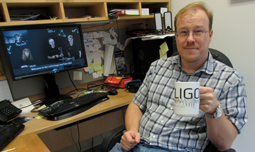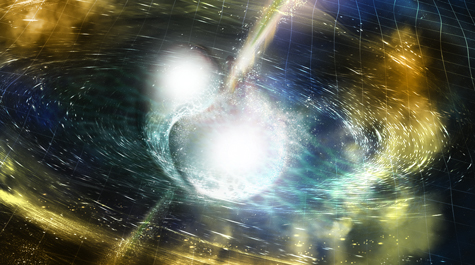Neutron stars collide: Science celebrates the event … and moves on
For the first time, scientists have directly detected gravitational waves — ripples in space-time — in addition to light from the spectacular collision of two neutron stars. This marks the first time that a cosmic event has been viewed in both gravitational waves and light.
The discovery was made using the U.S.-based Laser Interferometer Gravitational-Wave Observatory (LIGO); the Europe-based Virgo detector; and some 70 ground- and space-based observatories.
The observations of the collision, which took place 130 million light years from Earth, was announced by collaborators at an Oct. 16 webcast. The event validates a number of theoretical cosmological concepts from how heavy metals are created to what happens when stars die.
William & Mary’s Eugeniy Mikhailov, a member of the LIGO Science Collaborative, shared in the achievement related in the Oct. 16 announcement. The observation of two neutron stars colliding provided headlines for the day and will earn a place in the history of science, but Mikhailov points out that science itself moves on pretty quickly.
 “Right now, we publish a paper for every gravitational wave we detect. Soon there will be a catalog that only astrophysicists will look at,” he explained. “It’s the same with exoplanets. Ten years ago, we could count them on the fingers of one hand. Now there are thousands. Discovery of an exoplanet is not news anymore, it’s a routine operation.
“Right now, we publish a paper for every gravitational wave we detect. Soon there will be a catalog that only astrophysicists will look at,” he explained. “It’s the same with exoplanets. Ten years ago, we could count them on the fingers of one hand. Now there are thousands. Discovery of an exoplanet is not news anymore, it’s a routine operation.
“This happens in physics departments every day,” Mikhailov added. “Our undergrads routinely perform experiments that used to be Nobel Prizes 20 years ago.”
Mikhailov, an assistant professor in William & Mary’s Department of Physics, is a co-author on the neutron star paper, as is Mi Zhang, who received her Ph.D. in physics from William & Mary in 2017. Mikhailov and Zhang were also members of the LIGO team whose leaders received the 2017 Nobel Prize in Physics.
Neutron stars are the smallest, densest stars known to exist and are formed when massive stars explode in supernovas. As these neutron stars spiraled together, they emitted gravitational waves that were detectable for about 100 seconds; when they collided, a flash of light in the form of gamma rays was emitted and seen on Earth about two seconds after the gravitational waves. In the days and weeks following the smashup, other forms of light, or electromagnetic radiation — including X-ray, ultraviolet, optical, infrared and radio waves — were detected.
The observations have given astronomers an unprecedented opportunity to probe a collision of two neutron stars. For example, observations made by the U.S. Gemini Observatory, the European Very Large Telescope, and the Hubble Space Telescope reveal signatures of recently synthesized material, including gold and platinum, solving a decades-long mystery of where about half of all elements heavier than iron are produced.
The LIGO-Virgo results are published today in the journal Physical Review Letters; additional papers from the LIGO and Virgo collaborations and the astronomical community have been either submitted or accepted for publication in various journals.
“It is tremendously exciting to experience a rare event that transforms our understanding of the workings of the universe,” says France A. Córdova, director of the National Science Foundation (NSF), which funds LIGO. “This discovery realizes a long-standing goal many of us have had, that is, to simultaneously observe rare cosmic events using both traditional as well as gravitational-wave observatories. Only through NSF’s four-decade investment in gravitational-wave observatories, coupled with telescopes that observe from radio to gamma-ray wavelengths, are we able to expand our opportunities to detect new cosmic phenomena and piece together a fresh narrative of the physics of stars in their death throes.”














